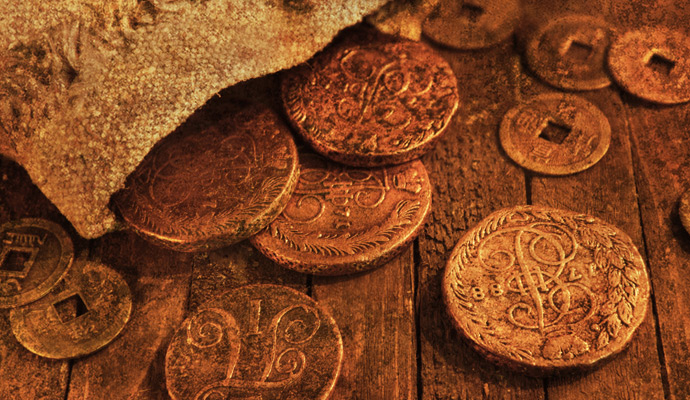How to "Truck" the Brand: Lessons from the Grateful Dead
Sound marketing principles from an unlikely source, the Grateful Dead rock group. Jerry Garcia and his fellow musicians emerged from the non-materialistic counterculture of the 1960's to create an exceptionally strong and lucrative brand name that has stood the test of time, and even Mr. Garcia's death in 1995. The basis of the Grateful Dead brand was the group's sustained personal relationship with its customers, derived from an unusual dedication to playing its distinctive and improvisational music at live performances.
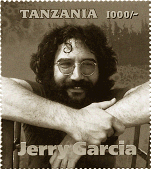 In the fickle world of music, where groups come and go with amazing rapidity, the Grateful Dead attracted audiences, sold albums and expanded their product line for 30 years. What lessons can a rock group teach the rest of us about marketing?
In the fickle world of music, where groups come and go with amazing rapidity, the Grateful Dead attracted audiences, sold albums and expanded their product line for 30 years. What lessons can a rock group teach the rest of us about marketing?
This is a story about brands and best practices. While its subject is a rock group -- and a defunct one, at that -- the lessons that it offers are universal. They are as relevant to the marketing of soup, roof tiles and shampoos as they are to the marketing of music. Marketing is marketing, after all, and there is always something to be learned from the world's best, even if their strategies and styles evolved during the Summer of Love in the streets of San Francisco rather than at meetings on Madison Avenue.
The group in question, the Grateful Dead, managed to hold on to its special perch in the fickle world of entertainment for more than 30 years, becoming a gold standard in an industry that has seen thousands of other rock "brands" come and go. Though serving as one of the key symbols of a 60's counterculture known for its disdain of materialism, the Dead also pioneered some of the most lucrative moves in the music business and were masters at turning their brand name into a cash cow.
At its height, the band pulled in as much as $95 million a year, not only from the usual sources of concert tickets and CD sales, but also from an ever-multiplying roster of spinoff products. Even now, more than a year after its fabled leader, Jerry Garcia, died and the surviving members went their separate musical ways, the group is a flourishing business entity.
The Dead musicians, and their managers, did all this by ignoring many of the usual rules. They were able to attract an army of loyal fans, known as Deadheads, without ever having a No. 1 hit. In fact, the Dead sometimes went years without producing a new album, preferring to reach their fans through frequent lengthy concerts. And the band completely eschewed mainstream music industry promotion and big advertising campaigns.
In essence, then, the Dead's story is a case study of substance over form in the context of niche marketing.
From the day it opened for business, the group had a clear sense of what its "product" should be and who its audience was. But while the band members appreciated the huge amounts of money they eventually earned -- and recognized the potential to earn still more -- the money never came first and they never let the bottom line dictate what went out the "factory door." By zealously protecting their product's quality, their customers were always sure of what that money was buying -- and never begrudged the fact that the band was getting wealthy in the process.
"The Dead have an image, a brand equity and trust from their customers," said Elizabeth Moore, corporate communications manager at the Procter & Gamble Company in Cincinnati. "They met a genuine consumer need and never became a me-too product. There are very clear parallels to products we market."
Sam I. Hill, chief marketing officer at Booz-Allen & Hamilton in Chicago, is no less a fan on business grounds. In his view, the Dead represent the best of "non-traditional" marketing, i.e., making a simple value proposition to a select group of customers without the hype and hoopla of an overwrought promotional campaign.
"The Dead established a long-term personal relationship with their customers and that was the basis of the brand -- it was sustained development against a single segment," Mr. Hill explained. "That's what marketing should be about, rather than glitz and tricks."
Mr. Hill sees parallels to other great marketers -- companies like Nike, IAMS Pet Foods, Snap-On Tools and MTV -- that concentrated initially on their products and only later on their profits. Nike set out to build a better running shoe; IAMS, a high-quality pet food. These companies simply believed in what they were doing and "were smart enough to see when it worked, and to exploit it," Mr. Hill said.
The Grateful Dead had similar smarts. The band members may have looked laid back on stage, where T-shirts, jeans and sneakers were de rigueur, but several became astute businessmen. The Dead incorporated in 1976 and, with the band members as the board of directors, became a serious business venture.
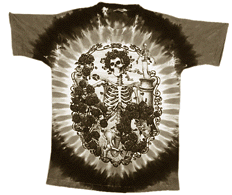
Decisions were made along the way -- allowing fans to tape live concerts, setting up a mail-order ticketing service to guarantee easier access to tickets as well as reasonable prices, bringing in vendors from the parking lots as official licensees and investing millions of dollars in state-of-the-art sound and light systems -- that had a profound impact on customer devotion and, thus, on extending the brand.
"But all decisions were made based on the integrity of the music," insists Dennis McNally, the band's publicist. "Many simply turned out to be great business decisions as well."
The thread connecting the Dead's music to products as disparate as running shoes and pet food, says Mr. Hill, is that "the great brands have a single, clear, intuitively compelling message or symbol."
For the Dead, that message was embodied in the lifestyle and community that developed around the band's ceaseless desire to play its music live and improvisationally. The Dead annually mounted four regional tours, which had, for their fans, the lure of a spiritual crusade. Tens of thousands of otherwise rational adults poured their souls -- and their wallets -- into the worship of the band. Well-coiffed baby-boomer stockbrokers, lawyers, doctors and academics now wear Jerry Garcia ties to their offices and love to trade stories about Dead shows they have attended over the years. Second- and even third-generation Deadheads are following in their footsteps.
Some sense of community is almost always the driver behind a product's success, marketing experts say. Benson P. Shapiro, a marketing professor at the Harvard Business School, says the key to creating a brand is the good feeling a buyer gets in acquiring and owning a product. Much of that feeling is tied to joining a group. "There is deep ego satisfaction and pleasure in belonging," Professor Shapiro said.
Though all successful rock musicians, from the Rolling Stones to Bruce Springsteen, have a large and loyal following, the community that grew up around the Grateful Dead is a breed apart in the depth of its dedication over the long haul.
The band earned its "incredible trust" from fans by never wavering from its original musical credo, said Peter McQuaid, the head of Grateful Dead Merchandising Inc., a key part of the Dead's business empire. "The group never packaged itself," he said. "What they did was for that night, for that moment."
Indeed, Mr. McQuaid said, when others seek to duplicate the band's success by asking how the group pulled it off, they are already missing the point. "The Grateful Dead became a success because they never asked that question," he said. "They just tried to make great music each and every night, and that brought incredible satisfaction to the customer."
Mr. McNally, the band's publicist, goes so far as to argue that what the Grateful Dead created was "not purposeful and is not duplicable on Madison Avenue."
But it is the Dead's very commitment to quality, and to the satisfaction of their audience, that is the foundation of any solid brand, marketing experts say.
"They followed some very good marketing principles, like control of the brand, creating a clear brand image and a well-defined value proposition," said Booz-Allen's Mr. Hill. "I don't see how that is not replicable."
What follows is a look at the five key principles of brand creation that were practiced, whether purposefully or not, by the Grateful Dead.
Know Thy Customer Intimately and Create a Product That Fills a Need
"Let it grow, greatly yield..."
(from "Let It Grow")
The Grateful Dead were just one of dozens of successful bands that emerged from the San Francisco Bay area in the mid-1960's. Their music, like that of the Jefferson Airplane or Big Brother and the Holding Company, became a focal point for the countercultural revolution then being waged by millions of the country's restless youth.
What set the Dead apart was their sound, which was built around the distinctive voice and guitar work of Mr. Garcia and was an unlikely fusion of the improvisational nature of jazz with a rock dance beat. It was a sound that left many people cold. But those who liked it, really liked it. Bill Graham, the famed rock promoter who was an early backer of the Dead, once said, "They are not the best at what they do, they are the only ones who do what they do."
And they did it from beginning to end, adds Mr. Hill of Booz-Allen. "They picked a customer group, remained true to it, close to it and didn't branch out," he said. "The Jefferson Airplane became the Jefferson Starship and went mainstream and started playing Muzak. The Dead never changed their music -- on purpose and by design, they never went mainstream."
The glue that bonded the Dead to their Deadheads was the group's live performances. Most of each show was unrehearsed and unplanned, with the band playing only what it felt was right for the moment. "They might start a song and then stop and say, 'Nah, not that one,' "Mr. McNally said. "It was like being present at a conversation of musical friends."
The conversation -- filled with old songs and new -- proved captivating. "It was musically fascinating -- that was what hooked me at first," said David Gans, an author of three books about the band and host of a nationally syndicated radio program, "The Grateful Dead Hour." "The reward was to be there."
How The Grateful Dead Earned their Money
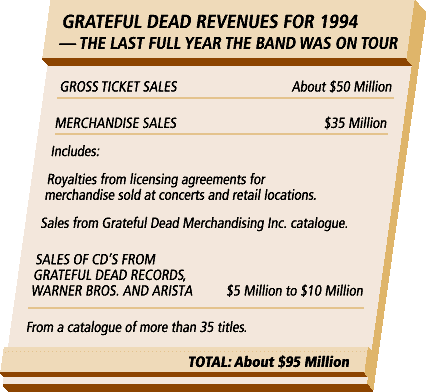
Source: Grateful Dead Merchandising Inc.
And so the Dead began to play countless live shows, in the process turning the accepted music industry formula on its ear. That formula casts recorded music as the profit center, and live appearances, in large part, as just one of the drivers. The typical rock performer records an album and then goes on tour to "support" its sales, singing the same new songs night after night at concerts that become little more than a cookie-cutter marketing tool.
But the lure of the Dead's music was the way in which it mutated on stage, from night to night, and the group's studio recordings have always been merely an afterthought for its fans. The band had only one certified megahit, the "In the Dark" album, and that came late in its career, in 1987. And the Dead have been all but ignored by the MTV generation, a fact that has only strengthened their hold on longtime fans.
 For the Dead, then, the concert became the profit center. In the group's last full year on tour, 1994, concert sales came to about $50 million while CD's pulled in just $5 million to $10 million. Another $35 million or so came from Dead merchandise, a big chunk of which was sold at the concerts.
For the Dead, then, the concert became the profit center. In the group's last full year on tour, 1994, concert sales came to about $50 million while CD's pulled in just $5 million to $10 million. Another $35 million or so came from Dead merchandise, a big chunk of which was sold at the concerts.
In business terms, those trademark concerts are a classic example of discontinuous improvement or change, said Ms. Moore of Procter & Gamble. With such change, a company does not try to improve an existing product with a new flavor or color, say, but rather to develop something radically different to fill a previously unidentified need.
At Procter & Gamble, Ms. Moore says, Tide was such a product in the 1940's, when it was introduced as the first synthetic detergent. Olean, a fat substitute now in test marketing with the Pringles brand of potato chips, is another example, she said. These kinds of "transcendent" products, like the Dead's concerts, inspire tremendous long-term loyalty.
"The Dead didn't worry about following musical trends," Ms. Moore said. "They created their own trend, which is what discontinuous change is all about."
Create a Community
"When there was no ear to hear, you sang to me..."
(from "Attics of My Life")
Jay Novack is a 35-year-old account executive at MHA Event Management in Norwood, Mass. Mr. Novack is also a Deadhead.
"There's a sense of community, a feeling we're all in this together," he said, explaining why. "You don't get that at other concerts where there may be 30,000 individuals. With the Dead, you go to six shows in seven nights at the Boston Garden and see the same people wearing the same clothes talking about the same things. That was the big draw for me, the sense of community."
Similar tight-knit communities abound in the marketplace. Owners of Harley-Davidson motorcycles and Jaguar, Mercedes-Benz and B.M.W. cars often become fanatical devotees of those products, joining clubs with fellow owners, attending regular gatherings to swap stories and product information and buying related paraphernalia like jackets, hats and coffee mugs. Ms. Moore recounted that when Tide was introduced, housewives would run out into the street if they spotted a P.&G. delivery truck driving by in order to share their experiences and show off their clean laundry.
The magic of the Grateful Dead brand is just how tight its community is. There are certainly some casual fans who have attended only a few concerts. Most fans, however, are serious members of an exclusive club.
"When you look at who the Deadheads are, they are people who were demonstrating in the 60's and are now Wall Street lawyers," said Harvard's Professor Shapiro. "They occasionally take a pro bono civil rights case to feel good about themselves. But being a Deadhead is even more important to them. It helps bring meaning to a life that got co-opted along the line."
The Dead's penchant for playing a radically different show every night was the cornerstone for creating the Deadhead community, according to Rebecca Adams, an associate professor of sociology at the University of North Carolina at Greensboro who is writing a book about the community. If the band had played the same songs at each performance, fans would have gone to only one or two shows. Instead, she said, the band made a lot of decisions that gave Deadheads a reason to know one another.
For example, in the 80's, the Dead decided to buck conventional wisdom and allow fans to tape their performances. In an industry where bootleg copies cost artists and record companies huge profits, the decision was tantamount to heresy. But Mr. Garcia was undeterred: "If we're done with the music, you can have it." The band even set up a special area at concerts for tapers to get the best sound.
In return, the Dead asked their fans to follow an honor system. They could keep or trade the tapes with fellow Deadheads, but they could not sell copyrighted material for profit.
In the Dead's case, the new open-door policy was a win-win decision. It wasn't likely to hurt record sales much, especially since the group didn't produce a studio album from 1981 to 1987. And it validated what was already a thriving Deadhead subcommunity of tapers. Thanks to the Internet, that subgroup has since grown into a giant global network.
But the tapes were only one strand in the ties that bound the community together. Serious Deadheads kept logs of each show, scribbling on notepads which songs were performed and in what order. Each nuance of the performance -- which note Mr. Garcia missed or lyric he forgot -- was also logged.
Deadheads like Paul Santinelli, a 27-year-old product manager in Sunnyvale, Calif., would sit for weeks, poring over play lists, trying to predict which songs would be performed at a show, comparing sets that were played at the same venue the year before or even 20 years earlier. Would the band play "St. Stephen," an old hit that it hadn't performed since 1979? "I got caught up in the anxiety," Mr. Santinelli says. "The dynamic changed from show to show, set to set."
Not only did this bizarre bookkeeping create yet another sense of community and clubbiness, but it also added to the band's mystique.
Creating such an aura around a brand is a powerful lure. Like the much discussed advertising for Calvin Klein clothing or Nike sneakers, which offer virtually no explanatory text, the implicit message is, "If we have to explain, you'll never understand." This attitude contributes mightily to the notion of an exclusive club in which membership helps define the brand.
The band capitalized on this devotion by creating a huge data base of shows and play lists, sold in book form and on diskette. Known as the Deadbase, it is now in its eighth printing.
All this fostered a sense of urgency that translated into massive ticket sales. Even as the band grew older, and Mr. Garcia, wracked by illness and drug addiction, played poorly, the Dead retained their lure.
"The feeling was they could be bad one or two nights in a row, but the next show could be the show, and you didn't want to miss that," said Mr. Novack, the Deadhead from Norwood, Mass.
Professor Shapiro says the ability to retain a brand's cachet is crucial to its long-term survival. "If you make it too ubiquitous, it loses cachet," he explains. "What the Dead did is make sure they didn't let records or CD's cheapen their image or make it pedestrian. That's an important thing; there has to be a sense of 'I'm in, you're out.' "
Professor Shapiro adds that the merchandising of the band has not turned off its followers because, for them, "it is more about affiliation, more of a sense of belonging, than crass merchandising."
Make Quality Job One
"Built to last while the years roll past..."
(from "Built to Last")
Despite their scraggly appearance, noted drug use and free-form style, the members of the band -- which also included Bob Weir, Phil Lesh, Mickey Hart and Bill Kreutzmann, among others -- had an unceasing commitment to improve their product and serve their audience.
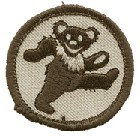 In part, they did that by keeping their employees nearly as loyal as their fans. At its zenith, the band's parent company, Grateful Dead Productions Inc., which was based in San Rafael, Calif., had more than 70 full-time employees, including a large road crew that stayed on the payroll even when a tour ended. From the early 70's, when everyone earned $125 a week, including the band members, the financial rewards grew astronomically and the wealth got shared.
In part, they did that by keeping their employees nearly as loyal as their fans. At its zenith, the band's parent company, Grateful Dead Productions Inc., which was based in San Rafael, Calif., had more than 70 full-time employees, including a large road crew that stayed on the payroll even when a tour ended. From the early 70's, when everyone earned $125 a week, including the band members, the financial rewards grew astronomically and the wealth got shared.
The road crew, for example, earned six-figure salaries, according to Mr. McNally, the publicist, and they also had generous profit-sharing and health plans. "There was simply no turnover," he said, "and no absenteeism." Indeed, Ram Rod, the crew chief, held his job for 28 years.
That degree of two-way loyalty, reminiscent of pre-downsizing days at I.B.M. or AT&T, has long been a characteristic of successful companies. Yet such devotion to the crew is foreign to the rock music business, where most bands let their workers go as soon as a tour is over. But for a band that spent as much time on the road as the Dead did, a stable staff was essential to make sure that everything ran well and on time.
The Dead also invested a small fortune in sound equipment, building perhaps the most sophisticated system in the industry.
By the 80's, the band decided to address the problems its fans were encountering trying to get concert tickets. While younger fans were more than willing to sleep out on sidewalks to keep their place in line, Deadheads with jobs and careers kept finding themselves shut out of events. So in 1983, the band set up its own mail-order ticket service.
"This way people with real lives could go to a show," Mr. McNally said. And the service helped end scalping scams as well.
As the band's popularity grew, it became a point of pride to keep ticket prices affordable. While bands like the Eagles, during their recent reunion tour, charged up to $100 a ticket, the Dead never asked for more than $30.
And, in general, the Dead let the Deadheads create their own environment at the concerts. Two exceptions: the band members were quite vocal about vendors selling copyrighted material and about gate-crashers. "If you don't have a ticket, don't come," they would tell the audience.
They also pushed hard to limit the flea market atmosphere in the parking lots around the concert sites. Often, so much was going on that some fans with tickets could not find spots to leave their cars.
Extend the Brand
"The Golden Road (to unlimited devotion)"
(a Grateful Dead song title)
In the mid-80's, Greg Burbank was a 21-year-old college dropout selling stickers and tie-dyed T-shirts in some of those parking lots. One night, he and his partner got a tap on the shoulder from a Dead crew member asking them to come in and talk to representatives of the band. "Rather than suing us for trademark infringement, they brought us on board," Mr. Burbank remembers.
Today, Liquid Blue Inc., Mr. Burbank's company in Lincoln, R.I., is one of the largest licensees of Grateful Dead merchandise, selling around $4 million worth to retail outlets each year.
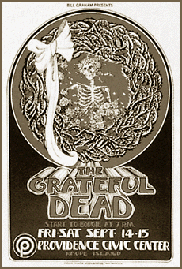 The band was, in fact, among the first rock groups to inspire vast sales of merchandise, of T-shirts, posters, stickers and the like. Though for many years they were content to let entrepreneurial fans reap the rewards, Mr. Garcia and his colleagues were eventually convinced that they were giving away more than a quarter of a million dollars in revenue each night. By taking over the merchandising themselves, they decided, they would not only gain the financial rewards, but also a measure of quality control. That is when they made the decision to bring in certain parking lot vendors, those who had sold high-quality goods, rather than force them all out of business.
The band was, in fact, among the first rock groups to inspire vast sales of merchandise, of T-shirts, posters, stickers and the like. Though for many years they were content to let entrepreneurial fans reap the rewards, Mr. Garcia and his colleagues were eventually convinced that they were giving away more than a quarter of a million dollars in revenue each night. By taking over the merchandising themselves, they decided, they would not only gain the financial rewards, but also a measure of quality control. That is when they made the decision to bring in certain parking lot vendors, those who had sold high-quality goods, rather than force them all out of business.
"These people had a real respect for the band and the music," said Mr. McQuaid, the head of the Dead's merchandising arm. "It was far more satisfying to have a relationship with someone with high regard for the group than to create a stable of artists inside our company."
Today, Grateful Dead Merchandising, with 22 full-time employees based in Novato, Calif., is a wholly owned subsidiary of Grateful Dead Productions, the group's umbrella corporation. The rock world's answer to L.L. Bean, the merchandising unit sends a quarterly publication to the 140,000 people in its data base, about half of whom are active buyers. A combination fanzine and catalogue, the publication offers up to 500 items -- from golf balls to baby clothes -- festooned with various Grateful Dead logos.
The direct-mail operation accounted for about 15 percent of the $35 million in non-music sales in 1994, with the rest coming from royalties from hundreds of licensees.
Non-music sales grew at a rate of 25 percent a year in the last three years of the band's life, according to Mr. McQuaid. They went up even faster in 1995, to a total of $45 million, in the wake of Mr. Garcia's death, of a heart attack at age 53, in August of that year.
Sales spiked so high that retail outlets quickly ran out of CD's and other band merchandise. The mail-order operation had to work around the clock for nearly four months to keep up with demand; it logged 15,000 calls a day for the first week after Mr. Garcia's death.
The band's ability to mix counterculture sentiment with unabashed marketing pitches was at work even then. In a note to readers of the catalogue, the Dead's merchandising arm expressed sorrow over Mr. Garcia's death and then noted, "Deadheads have expressed an overwhelming desire to have something ... anything ... some music, a memento, an amulet, a power object ... to console them, to inspire them, to remind them of the good times. And it's our privilege to be able to provide these things."
Sales of Dead merchandise in 1996 should be in the range of $40 million to $50 million, with the mail-order operation responsible for $10 million of that, according to Mr. McQuaid.
Jerry Garcia may be gone, but his army of Deadheads clearly lives on.
Find New Distribution Channels
"I will survive..."
(from "Touch of Grey")
So what happens to that army now?
The Dead built an institution, not just a rock band, notes Professor Shapiro of Harvard. "It's amazing how brands have a hold," he said. "People get very attached."
One measure of that attachment is the fact that the Dead's official World Wide Web site on the Internet still receives upward of 100,000 visits a day. What's more, there are hundreds of unofficial sites, including dozens with links to merchandise sales opportunities.
For his part, Mr. McQuaid believes the Dead brand can live on indefinitely, in terms of new products and through new channels of distribution. He points out that the money Deadheads spent on concert tickets may now be aimed at merchandise and music sales.
There will be plenty to choose from. There are tapes in the vault of thousands of Grateful Dead shows and the surviving members of the band intend to digitally mix these concerts and release them regularly for years to come. The remaining members have all embarked on separate projects with new groups and their continued presence on the road will likely fuel sales of both new and old Dead CD's.
As for new merchandise, Mr. McQuaid is starting to market a line of "lifestyle" products, including expensive tie-dyed towels and silk ties. The new items, to be sold in such mainstream retail outlets as Nordstrom, will be devoid of Dead logos or any other direct visual reference to the band.
"We're now discovering a large market that is emerging among baby boomers who aren't wearing Dead T-shirts but still want to show their devotion to the band," Mr. McQuaid said. "People in board rooms will wear Grateful Dead ties that only other Deadheads will recognize. It will be subtle."
Not everything is all that subtle, however. Landmark USA, a shoe manufacturer in Wisconsin, is marketing Dead Treads, a sandal that leaves a skeletal footprint in the sand. Mr. McQuaid says the sandals are available at Nordstrom and other retail outlets around the country.
Mr. McQuaid says that he is looking off-shore for additional marketing opportunities. "We're working on a distribution deal in Japan," he said. "There is huge interest there in the Dead and we expect to find a big market."
Mr. Burbank of Liquid Blue points out that long-defunct acts like Jimi Hendrix and Led Zeppelin continue to be among the most popular in merchandising circles. "Hendrix only toured for four or five years before he died," Mr. Burbank said. "The Grateful Dead have touched millions of people and there are 14-year-old kids who now think the Dead are a cool thing. That train was rolling for 30 years. It's not coming to an abrupt halt."
Mr. Hill of Booz-Allen agrees. Thanks to the band's sound marketing principles, the Dead's deep relationship with its customers will not dissolve any time soon, he said.
"It's easy to dismiss the Dead in a fad business where image is important," Mr. Hill added. "But the Dead managed to succeed over three generations. They are not a flash in the pan."
The Dead's own catalogue may have said it best: "Many thought that without a touring band as its focus, this remarkable community would evaporate like the mythical village of Brigadoon. Well, did we ever fool them! Because the Deadhead community is alive and well in many forms ... All it takes is some good tapes cranked up loud and room to twirl and it lives in the thousands of lasting friendships that grew out of the wonderful adventure we have been sharing all these years."
As brand testimonials go, that is about as good as it gets. ![]()
Photos courtesy of Grateful Dead Merchandising Inc.
Reprint No. 97106
| Authors
Glenn Rifkin, glennrifkin@worldnet.att.net Glenn Rifkin has covered technology for the New York Times and has written for the Harvard Business Review and Fast Company. He is coauthor of Radical Marketing (HarperBusiness, 1999) and The CEO Chronicles (Knowledge Exchange, 1999). |



